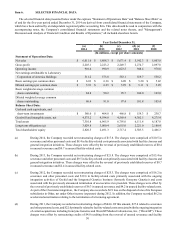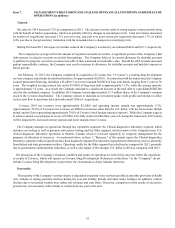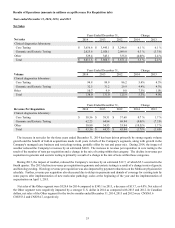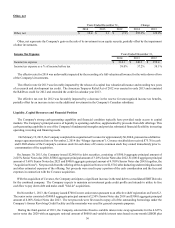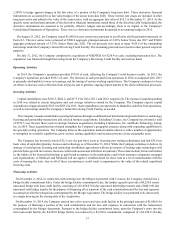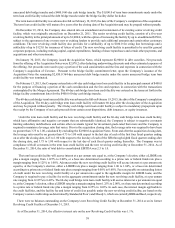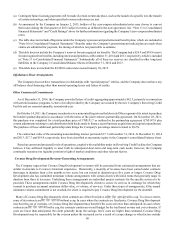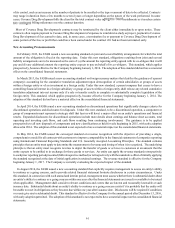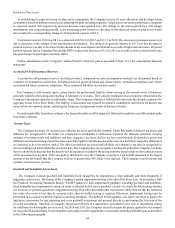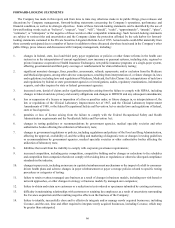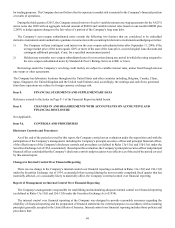LabCorp 2014 Annual Report Download - page 62
Download and view the complete annual report
Please find page 62 of the 2014 LabCorp annual report below. You can navigate through the pages in the report by either clicking on the pages listed below, or by using the keyword search tool below to find specific information within the annual report.
60
(a) Contingent future licensing payments will be made if certain events take place, such as the launch of a specific test, the transfer
of certain technology, and when specified revenue milestones are met.
(b) As announced by the Company on January 2, 2015, holders of the zero-coupon subordinated notes may choose to convert
their notes during the first quarter of 2015 subject to terms as defined in the note agreement. See “Note 11 to Consolidated
Financial Statements” and "Credit Ratings" above for further information regarding the Company’s zero-coupon subordinated
notes.
(c) The table does not include obligations under the Company’s pension and postretirement benefit plans, which are included in
"Note 16 to Consolidated Financial Statements." Benefits under the Company's postretirement medical plan are made when
claims are submitted for payment, the timing of which is not practicable to estimate.
(d) The table does not include the Company’s reserves for unrecognized tax benefits. The Company had a $24.9 and $34.9 reserve
for unrecognized tax benefits, including interest and penalties, at December 31, 2014 and 2013, respectively, which is included
in “Note 13 to Consolidated Financial Statements.” Substantially all of these tax reserves are classified in other long-term
liabilities in the Company’s Consolidated Balance Sheets at December 31, 2014 and 2013.
(e) This table does not include the $2,900.0 senior notes issued January 30, 2015.
Off-Balance Sheet Arrangements
The Company does not have transactions or relationships with “special purpose” entities, and the Company does not have any
off balance sheet financing other than normal operating leases and letters of credits.
Other Commercial Commitments
As of December 31, 2014, the Company provided letters of credit aggregating approximately $42.5, primarily in connection
with certain insurance programs. Letters of credit provided by the Company are secured by the new Company’s Revolving Credit
Facility and are renewed annually, around mid-year.
On October 14, 2011, the Company issued notice to a noncontrolling interest holder in its Other segment of its intent to purchase
the holder's partnership units in accordance with the terms of the joint venture's partnership agreement. On November 28, 2011,
this purchase was completed for a total purchase price of CN$151.7 as outlined in the partnership agreement (CN$147.8 plus
certain adjustments relating to cash distribution hold backs made to finance recent business acquisitions and capital expenditures).
The purchase of these additional partnership units brings the Company's percentage interest owned to 98.2%.
The contractual value of the remaining noncontrolling interest put totals $17.7 at December 31, 2014. At December 31, 2014
and 2013, $17.7 and $19.4, respectively, have been classified as mezzanine equity in the Company's consolidated balance sheet.
Based on current and projected levels of operations, coupled with availability under its Revolving Credit Facility, the Company
believes it has sufficient liquidity to meet both its anticipated short-term and long-term cash needs; however, the Company
continually reassesses its liquidity position in light of market conditions and other relevant factors.
Covance Drug Development Revenue-Generating Arrangements
The Company expects that Covance Drug Development's revenues will be generated from contractual arrangements that are
similar in structure to Covance’s historical experience. Historically, a majority of revenues have been earned under contracts
that range in duration from a few months to two years, but can extend in duration up to five years or longer. Covance Drug
Development also has committed minimum volume arrangements with certain clients with initial terms that generally range in
duration from three to ten years. Underlying these arrangements are individual project contracts for the specific services to be
provided. These arrangements enable Covance Drug Development's clients to secure its services in exchange for which they
commit to purchase an annual minimum dollar value, or volume, of services. Under these types of arrangements, if the annual
minimum volume commitment is not reached, the client is required to pay Covance Drug Development for the shortfall.
Many of Covance Drug Development's client contracts are either fixed price or with a cap. To a lesser extent,
some of its contracts are without a cap. In cases where the contracts are fixed price, Covance Drug Development
may bear the cost of overruns, or Covance Drug Development may benefit if the costs are lower than anticipated. In cases where
contracts are with a cap, the contracts contain an overall budget for the trial based on time and cost estimates. If
costs are lower than anticipated, the client generally keeps the savings, but if costs are higher than estimated, Covance Drug
Development may be responsible for the overrun unless the increased cost is a result of a scope change or other factors outside


